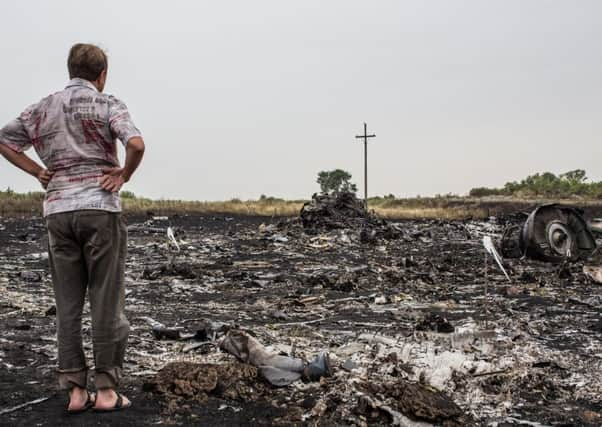Malaysia Airlines: The big questions to answer


THE raw video imagery of the remains of Malaysian Airlines flight MH17 makes horrific viewing and most mainstream western news organisations have opted not to broadcast it.
From this imagery alone it is possible to draw a number of important conclusions about how a £150 million airliner and its 298 passengers and crew met their fate.
Advertisement
Hide AdAdvertisement
Hide AdThe most telling images are of the tail of the aircraft, which can be clearly seen in lying a long way from other debris.
This must have separated from the aircraft at high altitude and spun away from the remainder of the Boeing jet.
Social media imagery of debris floating to the ground, taken just after the plane impacted, reinforces the view that it broke apart in mid air.
Beyond those obvious facts, evidence about what or who caused the disaster that befell MH17 are is less firm.
The Ukrainian government has been quick to blame pro-Russian rebels for firing a missile at the aircraft – a claim that was last night endorsed by United States President Barack Obama.
There was already convincing evidence to back up this claim.
Most telling has been an audio tape released by the Kiev security service of mobile phone conversations between alleged rebel commanders discussing the shooting down.
This includes reference to the remains of an Indonesian student’s possession being found in the wreckage.
Advertisement
Hide AdAdvertisement
Hide AdThe rebels then express varying degrees of distress that they have shot down a civilian plane by mistake.
Rebel spokesman have in turn denied the claims, saying that they do not possess the large radar-guided surface-to-air missiles that would be needed to hit an airliner flying at 33,000 feet.
Up to this week the rebels had only employed shoulder launched surface-to-air missiles, known as manpads, to shoot down Ukrainian helicopters and aircraft. These only have an effective ceiling of 10,000-12,000 feet, making them unable to reach a high-flying airliner.
THREE pieces of evidence suggest that the rebels do now have large air defence missile systems.
On Monday, the Ukrainians claimed one of their transport aircraft flying at high altitude was shot down by a large missile. This followed on from a rebel offensive in June, that led to them overrunning a Ukrainian barracks outside Donetsk containing several Buk mobile radar guided missile launchers, supporting vehicles and radars.
At about the same time western journalists in eastern Ukraine began reporting seeing Buk missiles deployed in rebel frontline positions. While these would give the rebels the means to bring down MH17, a motive for the attack is less clear.
A deliberate attack on an international airliner would be a public relations and diplomatic disaster for the self-styled People’s Republic of Donetsk and Lugansk.
Could “fog of war” or “general confusion”, those famous military adages, have played a part in the incident?
Advertisement
Hide AdAdvertisement
Hide AdTHE past week has seen a major escalation in air combat in eastern Ukraine, with one of Kiev’s transport aircraft and a fighter jet being shot down. The Ukrainians claimed that latter aircraft was shot down by a Russian fighter, adding to the hair-trigger environment in the region.
In such an environment, the potential for an aircraft to be mis-identified and engaged is enormous. The dangerous situation is made ten times worse by the 1980s vintage of air defence weapons deployed in the region by the Russians and Ukrainians. These lack modern computers and other devices to allow them to “interrogate” and identify the transponders fitted to civilian airliners, telling the crew the target it not a warplane.
If the rebels had indeed been able to press a captured Buk battery into service, then the possibility that a poorly trained and ill-disciplined crew of pro-Russian fighters engaged MH17 after they mistakenly identified it as a Ukrainian transport aircraft cannot be discounted.
INVESTIGATIONS into the loss of the Malaysian jet are at an early stage and some “out of the box” causes cannot yet be discounted.
Both the Russians and Ukrainians have several fixed air defence missiles sites in the region of the incident, including a number armed with the large S-300 super surface-to-air missiles. With a range of more than 100 kilometres, they could have hit the jet.
In 2001, the Ukrainian air defence missiles accidentally shot down a Russian airliner with the loss of 78 lives over the Black Sea. Poor operator training was blamed for the accident, which only came to light after missile fragments were found in bodies during autopsies. Until caught out, the Ukrainian military denied responsibility.
AS WELL all these conflict related theories, technical problems have to be considered.
The lack of concrete evidence so far and the uncertainty this creates makes it all the more important that an independent investigation team be allowed access to the crash site to examine the wreckage.
Advertisement
Hide AdAdvertisement
Hide AdEven if the black box is recovered from the crash site, it will not tell the whole story.
It will not for example give any information about a missile attack, only what the airliner and its crew were doing up to the point of impact.
To get to the bottom of what other aircraft and missile batteries were doing at the time MH17 was lost, investigators will need to get access to the raw radar data collected by both the Russian and Ukrainian air defence radar networks that were monitoring air activity over eastern Ukraine and southern Russian at the time.
The reaction of Moscow and Kiev to such a request will also be a key indicator of whether either protagonist thinks they have something to hide.